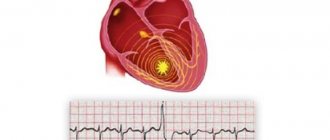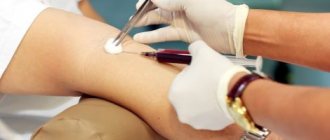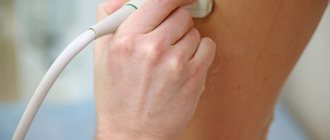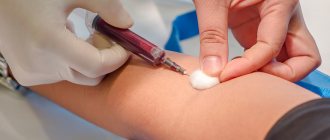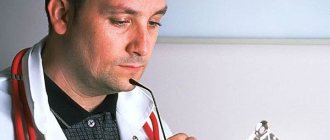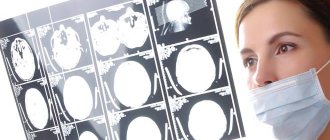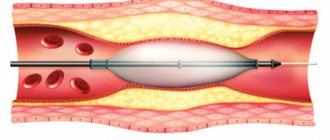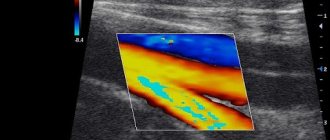Cardiac bradycardia is a type of arrhythmia in which the heart rate drops below 60 beats per minute. The functioning of the sinus node is disrupted; it weakly produces electrical impulses. This is a normal state for a professional athlete.
The appearance of bradycardia in untrained adults may be a consequence of serious pathology. Without timely medical care, there is a high probability of dangerous complications, including death.
Bradycardia: main causes
The development of an extracardiac form of bradycardia can occur due to neuroses with actual autonomic dysfunction, neurocirculatory dystonia, pressure on the eyeballs or on the carotid sinus (which occurs due to wearing a tight tie, collar), as well as as a result of increased intracranial pressure (brain contusion, meningitis, brain tumor, brain edema, etc.).
In addition, this type of bradycardia can develop due to peptic ulcer of the duodenum and stomach. The causes of organic bradycardia include myocardial dystrophy, cardiosclerosis, myocarditis and myocardial infarction. This type of disease is provoked by fibrous and degenerative changes in the area of the sinus node or disorders associated with myocardial conductivity, which is accompanied by the development of a state of bradycardia with its inherent symptoms.
An organic lesion that occurs in the pacemaker leads to the development of a weakness syndrome that is relevant for the sinus node, in which the frequency of pulse generation undergoes a sharp decrease. An accompanying factor of this condition is sinus bradycardia, which occurs with extremely rare, although rhythmic, heart contractions. At the same time, a change from bradycardia to a state of tachycardia may occur, or an alternation of spontaneous types of pacemakers may occur. The extreme degree of damage in the sinus node is the failure of the automaticity function, against the background of which the production of electrical cardiac impulses ceases.
In the case of a lesion affecting the conduction pathways of the myocardium, a blockade of impulse conduction develops, due to which, accordingly, a certain part of the signals generated through the sinus node is subject to blocking, which, in turn, cannot reach the ventricles, which is why the development of , again, bradycardia.
A concomitant factor in the development of drug-induced bradycardia is the use of morphine, quinidine, cardiac glycosides, beta-blockers and calcium channel blockers, as well as some other drugs.
Toxic bradycardia is accompanied by severe states of intoxication, provoked by uremia, hepatitis, sepsis or typhoid fever, poisoning by compounds with organophosphorus components, as a result of which there is a slowdown in the processes of automatism and subsequent conduction to the heart. This group also includes this type of bradycardia, which occurs against the background of a severe form of hyperkalemia or hypercalcemia.
As for the initially noted bradycardia of athletes, the heart rate for it is about 40 beats/min, and these indicators are relevant even during the daytime. The reason for the occurrence of this condition lies in the peculiarities of their autonomic regulation.
The causes of bradycardia can also be natural processes associated with the aging of the body, and it also happens that the causes of this condition cannot be determined at all, which defines it as bradycardia in an idiopathic form.
Kinds
The classification of bradycardia includes the following types:
By localization
- Sinus bradycardia - disturbances in the heart rate of the heart are caused by changes in the sinus node.
- Bradycardia during heart block - which can be caused by disturbances in the signal conduction between the sinus node and the atria (sinoatrial) or between the atria and ventricles (atrioventricular).
By the nature of development
- Extracardiac – caused by the influence of external factors on the body (cold, medications, physical activity.
- Intracardiac – caused by the impact of internal factors on the heart (changes in hormonal levels, heart disease, neurological disorders and others).
- Physiological (functional) – caused by physiological restructuring of the body under the influence of physical causes (sleep, playing sports);
- Pathological – acts as one of the symptoms of various diseases.
By etiology
- Extracardiac (neurogenic);
- Organic – caused by heart damage);
- Toxic – caused by poisoning, incl. and for infectious diseases;
- Medicinal – caused by taking certain medications;
- Idiopathic - the cause has not been established.
By severity (degree)
- Light – characterized by a heart rate of 59-50 beats/min;
- Moderate - characterized by a heart rate of 49-40 beats/min;
- Severe – characterized by a heart rate of 40 beats/min. and less.
Types of disease
There is no specific classification of cardiac bradycardia in adults, but the following types of disease are more often diagnosed:
| Name | Description |
| Sinus | A common type of cardiac bradycardia. The cause is atherosclerosis, heart damage, deficiency of vitamins and microelements. |
| Sinoatrial | A type of disease that appears after suffering pathologies (heart attack). With sinoatrial bradycardia, the heart becomes covered with scars. A dangerous condition, against the background of which the process of signal transmission to the ventricles slows down. |
| Neurogenic | Bradycardia occurs as a result of damage to the nervous system. Provoking factors are a malignant tumor in the brain or serious mental disorders. |
| Extracardiac | Occurs more often against the background of neurosis. Accompanying symptoms are increased intracranial pressure. |
| Organic | Pathological changes occur as a result of dysfunction of the sinus node. When the electrical impulse decreases, the risk of a drop in heart rate increases. |
| Toxic | Bradycardia is provoked by certain diseases, due to which the human body weakens (hepatitis). The same goes for blood poisoning and chemical poisoning. |
| Medicinal | Pathological changes are provoked by certain medications. |
| Idiopathic | More often, older people experience such cardiac bradycardia, since older people experience senile changes in the body. They affect not only the heart, but also blood vessels. |
In most cases, medications are not required to correct heart problems. It is enough to adjust your lifestyle. But there are dangerous conditions when you will need not only conservative therapy, but also surgical intervention.
Reasons for appearance
It is important to establish the source of pathological changes in the human body, since the method of therapy depends on the information received after diagnosis. In most cases, bradycardia is a consequence of dysfunction of the cardiovascular system. The cause may also be natural factors or pathological disorders in the functioning of internal organs.
| Name | Description |
| Physiological reasons |
|
| Pathological factors |
|
This is interesting: Sinus bradyarrhythmia in a child or teenager. What is it, playing sports
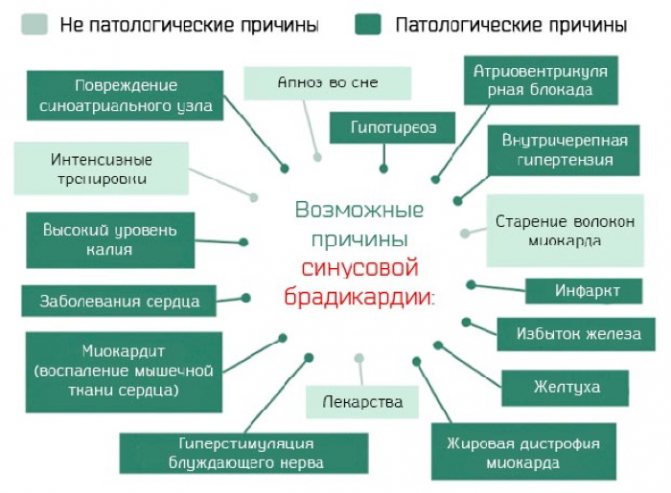
Heart bradycardia in adults of physiological origin often does not require special treatment. In case of pathological changes, it is necessary to undergo a full medical examination. Against the backdrop of serious malfunctions in the functioning of internal systems and organs, blood volume may decrease, followed by serious complications.
Bradycardia causes
There are only two main causes of cardiac bradycardia – physiological and pathological. The first includes:
- bradycardia, recorded in trained people and athletes. Ordinary, everyday stress is not something prohibitive for them; the body begins to send signals about the need for higher frequency only under extreme stress, and then the heart rate increases;
— this also includes sinus bradyarrhythmia in children and adolescents;
— congenital complete AV block;
- idiopathic bradycardia.
The pulse with bradycardia, in these cases, will certainly increase with physical activity, and with sinus bradyarrhythmia it will also become correct.
The pathological form of bradycardia includes conditions that arise due to:
— CCSU (sick sinoauricular node syndrome);
- sinoauricular block;
— arrest of the sinoauricular node; — blockades at the level of the AV node;
- complete transverse blockade;
- rhythm disturbances such as atrial fibrillation (bradyform) or Frederick's syndrome (a combination of atrial fibrillation and complete AV block);
- overdose of various drugs, mainly antiarrhythmics;
— poisoning with various cardiotropic poisons and substances;
- damage to the brain and/or peripheral nervous system;
— disruption of the endocrine glands (for example, with hypothyroidism);
— trauma (a case of a bullet wound to the heart with damage to the His bundle is described);
— HIHD (chronic ischemic heart disease);
- myocardial infarction;
— terminal form of renal, liver failure;
- electrolyte disturbances (excess potassium and/or calcium in the blood).
Bradycardia can be a reflex, when exposed to or stimulated, for example, the carotid sinus (when stopping an attack of tachycardia or when we accidentally tighten a tie around the neck, or put on a tight collar, etc.), when pressing on the eyeballs (also used when stopping an attack tachycardia).
Bradycardia can be one of the side effects of therapy, for example, when prescribing Beta blockers to patients with CHIHD or with various rhythm disturbances, the pulse can drop to 55 beats per minute. The dose of the drug is selected based on the level of heart rate, not allowing the heart rate to drop below 55 beats. in a minute.
Diagnosis of bradycardia
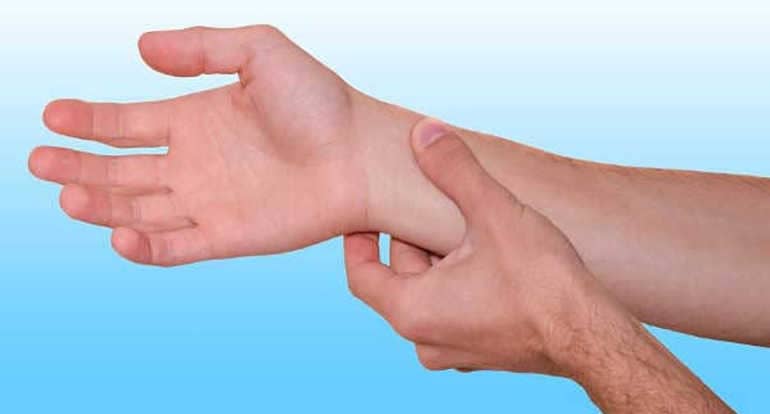
During the consultation, the specialist listens to the patient’s complaints and determines the parameters necessary to make a diagnosis. Pulse during bradycardia is measured at rest and in a sitting position. If the heart rhythm does not go astray, then the problem is in the sinus node.
The diagnosis made during the initial consultation should be clarified using hardware diagnostics. If bradycardia on the ECG does not immediately show characteristic features, daily ECG monitoring is prescribed. It is performed by attaching a device to the patient's body that will record the work of the heart. The patient must keep a diary with notes of all his actions.
If the cause of a rare pulse is heart pathology, an ultrasound of the heart is prescribed. The following can also help in making an accurate diagnosis: TEE (ECG through the esophagus), EPI, coronary angiography.
Fetal bradycardia is detected by ultrasound. If a specialist detects deviations, one of the effective methods of additional examination is prescribed:
- ECG (18-24 weeks);
- Auscultation (from 20 weeks);
- CTG (from 32 weeks).
The frequency of standard examinations using an ultrasound machine increases depending on the severity of the deviation, as well as the well-being of the mother and child.
Treatment of bradycardia
How to treat bradycardia? The treatment regimen for bradycardia depends on the etiology of the disease, pathogenesis, concomitant diseases and the patient’s health status, however, in most cases it looks something like this:
1. Elimination of an unfavorable factor. 2. Drug treatment. 3. Diet. 4. Surgical treatment.
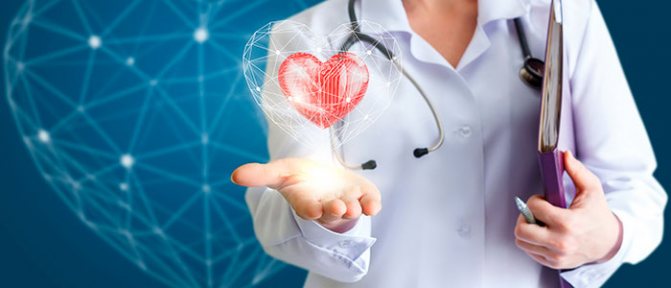
Factor exclusion
It is not for nothing that collecting anamnesis and complaints is the first point of diagnosis, not only of bradycardia, but also of other diseases. It is during this period that all information is collected in order to find and eliminate the factor that could cause the pulse to drop.
Thus, life correction is the first step in treatment. In many cases, reducing the dose or stopping a drug, or limiting the patient's smoking and alcohol abuse leads to normal heart function.
Drug treatment
The choice of drugs depends on the type of bradycardia and its concomitant disease
It is very important to find the root cause of low heart rate. It is unacceptable to relieve symptoms without treating the underlying disease, therefore, it is imperative to normalize hormone levels, eliminate inflammatory or tumor processes, and stop the infection
Next, we will consider drugs that are primarily aimed at increasing heart rate.
Medicines for bradycardia
Beta-adrenergic agonists (stimulants of β1 and β2 adrenergic receptors) – help improve atrioventricular conduction and accelerate the frequency of contraction of the heart muscle:
- "Isadrin" - used in a dosage of 2-20 mcg in combination with a 5% glucose solution;
- “Isoprenaline” has the property of relieving heart blocks, which leads to increased myocardial heart rate and prevents the development of cardiogenic shock. Used in a dosage of 1 tablet 3-4 times a day, or intravenously with a 5% glucose solution;
- "Orciprenaline sulfate";
- "Ephedrine hydrochloride" is another stimulant of β, as well as α-adrenergic receptors, which also has a vasoconstrictor effect. Contraindications are organic heart disease, hypertension, hyperthyroidism.
"Atropine" - used in a dosage of 0.6 to 2 mg, 2-3 times a day, intravenously or subcutaneously.
Antihypertensive drugs - prescribed in case of high and high blood pressure:
- "Bisoprolol" - blood pressure is reduced by blocking β1-adrenergic receptors;
- “Indapamide” - blood pressure is reduced by removing excess fluid from the body, i.e. it is a diuretic;
- "Celiprolol" - a decrease in blood pressure occurs due to a pronounced vasodilator effect;
- "Trifas" - a decrease in blood pressure occurs due to the removal of sodium (Na) and chlorine (Cl) from the body.
- Coenzyme Q10.
Other medicines:
- “Zelenin Drops” - used for moderate bradycardia in a dosage of 35-40 drops, 2-3 times a day.
- L-carnitine (vitamin B11) is an antiarrhythmic agent that has a strengthening effect on the muscle tissue of the myocardium and others, which prevents the development of a heart attack;
- “Mexidol” is used for problems with blood circulation, which helps the brain and other internal organs cope with oxygen starvation.
Diet
A diet for bradycardia will help adjust the body’s energy expenditure on food processing, as well as provide the heart and other organs with additional amounts of important vitamins and minerals that play an important role in maintaining their normal functioning.
Nutrition rules: 5-6 times a day, without overeating, with limited consumption of salt (up to 3-5 g/day), fatty, fried, chips and other unhealthful and harmful foods rich in cholesterol. Cook by steaming, boiling or stewing.
Place special emphasis on foods high in magnesium, selenium, calcium, phosphorus, omega-3 and vitamins B6, B9.
What can you eat with bradycardia: lean meats and fish (chicken, hake, pollock), low-fat dairy products, whole grain bread, pasta, cereals (buckwheat, rice, oats), nuts (walnuts, peanuts, almonds), dried fruits, fresh fruits , greenery.
What not to eat: pickles, canned food, pork, smoked meats, spices, alcohol.
In medical institutions, for arrhythmias and other problems with the cardiovascular system, a specialized dietary menu is prescribed - diet No. 10, developed by M.I. Pevzner.
Surgery
In case of frequent fainting, Morgagni-Adams-Stokes syndrome and the risk of sudden cardiac arrest, as well as the lack of positive results of conservative methods of therapy, the doctor may prescribe the installation of a pacemaker.
This device produces small electrical impulses, thereby stimulating the heart to contract with the required rhythm artificially.
Treatment methods
Heart bradycardia in adults requires medical intervention if pathological changes are accompanied by pronounced clinical symptoms. A mild form of the disease can be eliminated with the help of vitamin complexes and a balanced diet. In severe situations, hospitalization of the patient and a course of treatment with specially selected medications are required.
Medications
Any medicine for the heart is prescribed by a general practitioner or cardiologist. It is important to follow the specialist’s recommendations and follow the dosage so as not to worsen your health condition. Many drugs provoke adverse reactions.
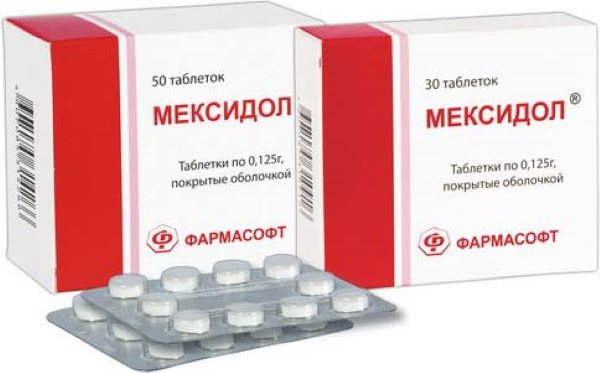
| Group of drugs | Name | Application |
| Antiarrhythmic drugs | "Coenzyme Q10", "Mexidol" | Medicines restore blood pressure and heart function. The capsules are taken orally whole with water. The adult dosage is 30 mg 2 times a day. per day. The course of treatment lasts on average 1 month. |
| Medicines to lower blood pressure | "Indapamide", "Bisoprolol" | Medicines reduce blood pressure and have a diuretic and vasodilator effect. It is recommended to take the drug 1 tablet. in the morning hours. |
| Drugs to stimulate heart contraction | "Ephedrine", "Caffeine" | Medicines are prescribed 2 times. per day 25-50 mg for 10-15 days. |
| Hormonal medications | "Levothyroxine", "Litironine" | A thyroid medication that is taken on an empty stomach in the morning. The initial daily dosage is 50-100 mcg. |
Additionally, the cardiologist prescribes vitamins to improve overall well-being and strengthen the heart (E, C, B6, F). Cholesterol levels are reduced and the walls of blood vessels are strengthened. Organ cells receive more oxygen, which improves blood circulation. Vitamins also prevent the formation of plaques.
Traditional methods
Doctors recommend treating the heart using complex methods.

To eliminate cardiac bradycardia, you can use folk remedies:
This is interesting: Hepatitis A, B, C, D and E in children - causes and symptoms
| Name | Recipe | Application |
| Walnuts | For 500 g of kernels you will need 200 g of sugar and the same amount of sesame oil. Add 4 lemons, after cutting them into 4 parts. Sugar can be replaced with honey if there is no allergic reaction to the product. Mix all ingredients well and pour boiling water (1 l). | The finished medicine is taken 1 tbsp. 3 r. per day before meals 30 minutes. |
| Honey, lemon and garlic | Wash lemon (10 pcs.), pour boiling water over it, squeeze out the juice. Peel and chop garlic (10 medium heads) into a paste. Mix all components well until a homogeneous mass is obtained. Add honey (1 l). Close the resulting mixture and leave to infuse for 10 days. | The finished product is taken 30 minutes before meals, 4 tsp. The course of therapy lasts 3 months. |
| Herbal collection | Mix currant leaves, wormwood and sainfoin flowers in equal proportions (2 tsp) in a thermos. Grind the tea penny root. Add 1 tsp. to the herbal mixture. Pour the resulting mass with hot water (1 tbsp.) and leave for 12 hours. Strain the finished infusion well and add liquid to make 200 ml. | The finished medicine must be drunk in one day in several doses. The course of treatment lasts 1 week, then it is recommended to take a break and continue therapy. |
Hawthorn has a positive effect on vascular tone and supports the activity of the central nervous system. Yarrow extract increases liver secretion, which increases appetite and stimulates nerve receptors. The activity of the central nervous system increases and the functioning improves.
Other methods
In addition to taking medications and using traditional recipes, patients with cardiac bradycardia need to change their diet.
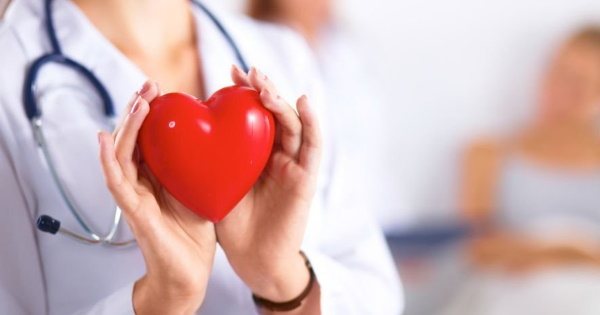
| Authorized Products | Prohibited Products |
| fresh vegetables and fruits greenery lean meat fermented milk products seafood porridge and cereals | fried, fatty and salty foods canned food sweets, baked goods cranberries, currants, cherries, cherries, apricots alcohol animal fats |
It is better to cook dishes using steam or water, and reduce salt consumption to a minimum. The calorie content of the daily diet should not exceed 1700 kcal. If there is no positive dynamics after drug therapy, the patient is indicated for surgical intervention.
Indications for surgical intervention are as follows:
- heart rate (HR) fluctuates between 30-40 beats;
- the person often loses consciousness;
- the patient complains of heart failure.
The patient is fitted with a pacemaker to restore normal functioning of the cardiac system.
Lifestyle
Mild to moderate bradycardia does not require a major change in usual physical activity or daily activities. It is enough to follow the principles of a healthy lifestyle, the basics of a balanced diet and develop an adequate work and rest regime.
It is useful for both categories of patients to know that with bradycardia it is advisable to eat foods such as walnuts, a mixture of honey, lemon and garlic, as well as yarrow decoction, as these products have a beneficial effect on the contractility of the heart muscle. All persons with diseases of the cardiovascular system need to get rid of bad habits, follow a diet containing low-calorie foods and relax in the fresh air more often.
If bradycardia develops in a pregnant woman, the ability to bear a child depends on the underlying disease. Typically, mild to moderate bradycardia does not affect the oxygen supply to the fetus. If the expectant mother is taking any medications, she must agree on the possibility of taking them with the attending obstetrician.
Basics of treating the disease
How to treat bradycardia? Can it be cured at home? And is it always necessary to treat this disease?
Treatment of bradycardia almost always takes place in a hospital; this disease can be cured at home only if it is caused by fasting for the purpose of losing weight. If the diet has not been very long, and only mild or moderate bradycardia is diagnosed, then the violations can be corrected with proper nutrition.
In all other cases, examination and treatment in a hospital setting are required. Children, regardless of the causes of the pathology, are treated only under the supervision of a pediatric cardiologist.
Depending on what caused the decrease in heart rate, the following is carried out:
- elimination of the provoking factor (giving up bad habits, treating infectious processes), very often this is enough to eliminate the symptoms that have arisen;
- establishing a proper work and rest regime;
- selection of adequate physical activity appropriate to age and general health;
- creating a menu for nutritious meals;
- prescription of medications.
In severe cases (usually with weakness of the sinus node or with complete blockades, when the conduction of the cardiac impulse is completely blocked), bradycardia is treated by implanting a pacemaker. The indication for implantation of a rhythm stimulator is a decrease in heart rate below 40 per minute, if there is a pause between contractions and pauses of more than 2 seconds or in the presence of frequently occurring bradyarrhythmia.
If there are no dysfunctions of the organs, and the person’s general condition does not suffer, then drug treatment is not required. Such people are given recommendations regarding their daily routine and proper nutrition, leaving them registered with a cardiologist at a risk group for the development of pathology.
Bradycardia in children and adolescents
Sinus bradycardia is often observed in childhood. Its etiology, clinical manifestations and course are similar to the course and symptoms of the disease in adults. The difference is that the diagnosis of bradycardia in a child over 6 years of age is made when the heart rate drops to 70-80 beats per minute. Bradycardia in children is caused mainly by the same reasons as in adults: increased excitability of the vagus nerve, exposure to hypoxemia, various infections and intoxication of the body. In adolescents, the cause of bradycardia may be a lag in the development of the cardiovascular system from the rapid growth of other organs and metabolic disorders.
What is bradycardia and why is it dangerous?
Heart contractions are considered to be slow if their frequency becomes:
- less than 60 per minute in adults;
- less often 60-70 per minute in children from 1 to 6 years old;
- less than 100 per minute in infants.
Rare contractions of the heart lead to blood circulation slowing down, tissues and organs receiving less oxygen and nutrients, and metabolism slowing down. Against the background of starvation of vital systems and organs, a person feels:
- weakness;
- cold sweat;
- severe fatigue even after usual work;
- dizziness;
- darkening of the eyes;
- blurred vision due to flashing flies;
- loss of consciousness (the duration of fainting depends on the severity of the disease).
But why is bradycardia dangerous? And the fact that if it is not treated in a timely manner, then insufficient blood supply and the resulting symptoms can provoke the following complications:
- ischemic myocardial damage, accompanied by attacks of angina of varying intensity;
- the occurrence of chronic circulatory failure;
- VSD, often of the hypotonic type, but the development of hypertension is also possible;
- Morgagni-Adams-Stokes attacks, when sudden fainting is accompanied by convulsions caused by cerebral hypoxia (it differs from an epileptic seizure in that it occurs suddenly, there are no precursors characteristic of epilepsy);
- sudden cardiac arrest.
In children with bradycardia, symptoms are more severe than in adults and pose a greater health hazard. This is due to the fact that in the child’s body the processes of adaptation to unfavorable factors are not sufficiently developed and the distribution of intake for nutrition of vital organs is not always complete. Severe bradycardia in children often provokes the development of convulsive seizures, during which cardiac arrest and death are possible.
How is bradycardia treated?
Severe bradycardia of a pathological nature usually requires treatment. The treatment regimen is prescribed to each patient individually based on the results of numerous studies and analyses. It is the anamnesis that helps to see the full picture of the disease and allows you to prescribe the necessary treatment.
First of all, the actions of cardiologists are aimed at eliminating the cause of the development of pathology. For example, if bradycardia occurs as a result of prolonged and uncontrolled use of medications, then their dose should be reduced, and some medications should be completely eliminated or replaced with safer ones. If bradycardia has a toxic, organic or extracardiac form, the patient’s underlying disease is treated, as a result of which the heart rate is restored.
If the patient has hemodynamic disturbances, the doctor prescribes Izadrin, ginseng root, caffeine, belladonna, ephedrine and others. The dosage is determined strictly individually. These drugs increase heart rate and blood pressure and prevent the consequences of pathology. However, medications can only be prescribed by a health care professional, since self-medication often leads to overdose, complications of bradycardia and exacerbations of other chronic diseases due to improper selection of medications.
The reasons to start therapy for bradycardia are:
- symptoms characteristic of circulatory disorders - dizziness, fainting;
- attacks of bradycardia that occur more and more often, causing discomfort to a person;
- chronic diseases that may lead to a decrease in heart rate;
- low blood pressure;
- temporary disability;
- Heart rate is below 40 beats/min.
The goal of treatment is to restore blood circulation and reduce the risk of complications. As a rule, people who complain of bradycardia are not hospitalized - treatment is carried out at home. If the patient is diagnosed with severe heart pathologies and other serious diseases that threaten his health and life, then treatment is carried out exclusively in an inpatient setting.
Characteristic symptoms
A physiological decrease in heart rate or moderate bradycardia practically does not manifest itself. This condition is not accompanied by circulatory disorders, and therefore there are no clinical symptoms. However, already when the heart rate drops to 40 beats/min. a person may feel:
- dizziness;
- shortness of breath;
- short-term loss of consciousness;
- fatigue;
- blood pressure fluctuations;
- compressive pain in the chest from the heart;
- short-term visual impairment;
- impaired memory, concentration;
- confusion of consciousness and thinking;
- swelling of the limbs;
- pale skin.
If the sinus rhythm slows down, the human brain is the first to react, experiencing hypoxia - a lack of oxygen. This can cause convulsions and short-term loss of consciousness. However, this particular condition is considered the most dangerous: if the attack drags on, respiratory arrest may occur, leading to the death of the patient.
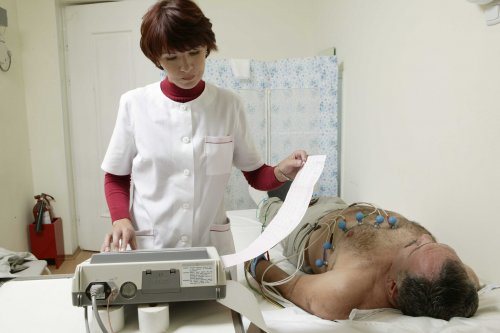
Causes
Extracardiac bradycardia
This type is a manifestation of an underlying disease not related to the heart. Most often, with a condition such as bradycardia, the causes lie in the occurrence of the following pathological conditions:
- Subarachnoid hemorrhages, meningitis, as well as other diseases accompanied by.
- Peptic ulcer disease.
- Hypofunction of the thyroid gland.
- Vegetovascular dystonia.
It should also be said that extracardiac bradycardia can be caused by pressing on certain points. A decrease in heart rate is observed when pressure is applied to the eyeballs or carotid sinus.
Organic bradycardia
In this case, there is a direct effect of the pathology on the heart and, as a result, a decrease in heart rate. The following diseases are identified as causes of organic bradycardia:
- Acute coronary syndrome.
- Myocarditis of bacterial and viral etiology.
- Cardiosclerosis.
- Myocardial dystrophy.
Drug-induced bradycardia
A slow heartbeat may occur as a result of exposure to certain medications. Most often, bradycardia occurs due to improper use of drugs from the following groups:
- Beta blockers.
- Glycosides.
- Narcotic analgesics.
- Antiarrhythmic drugs.
- Calcium channel blockers.
- Sympatholytics.
Toxic bradycardia
One of the features of this form of arrhythmia is that it completely disappears some time after stopping the drug and does not require special treatment. In the toxic form of bradycardia, the causes can be quite different, ranging from various infections to pesticide poisoning. Thus, the following infectious diseases are very often accompanied by bradycardia:
- Typhoid fever.
- Hepatitis.
- Generalized infections.
Also, a decrease in heart rate is observed in case of poisoning with organic phosphorus compounds. Some experts classify as toxic bradycardia a slowdown in rhythm associated with an excess of calcium or potassium in the body.
Separately, physiological bradycardia in pregnant women should be highlighted. It occurs in women who were actively involved in sports before conception. This slowdown in rhythm does not pose any danger to the mother or fetus.
The so-called “athletic heart” leads to the formation of a physiological disturbance of the heart rhythm in athletes, the occurrence of which is explained by a number of features, namely:
- With proper distribution of loads, the heart is trained, which increases its performance. Such a heart, at rest, uses resources extremely sparingly, and during physical activity it is fully activated. Studies have shown that many athletes, even with heart rates below 60 beats per minute, do not have circulatory problems.
- Trained people have a highly developed capillary network, which helps deliver oxygen and nutrients to tissues and organs.
Causes of pathological bradycardia
The reasons leading to the development of the organic form of bradycardia are:
- cardiosclerosis;
- myocarditis;
- myocardial dystrophy;
- myocardial infarction.
Against the background of these diseases of the heart muscle, fibrotic and degenerative changes occur in the sinus node or pathways, which leads to a slowdown in heart rate. The organic form of bradycardia is formed against the background of sick sinus syndrome, manifested by a decrease in the generation of electrical impulses in it. This is accompanied by rare but rhythmic contractions of the heart, i.e. sinus bradycardia or alternating bradycardia and tachycardia.
Diagnostics
A correct diagnosis will allow you to choose the most effective treatment.
To determine cardiac bradycardia, it is necessary to undergo a full examination, which includes the following diagnostic measures:
| Name | Description |
| Electrocardiogram (ECG) | The examination allows you to determine heart rate, sinoatrial or atrioventricular block. Daily observation will be required if the patient complains of prolonged bradycardia or if there is no positive result after drug therapy. |
| Transesophageal electrophysiological study (TEPE) | A diagnostic method that allows you to examine the conduction pathways of the heart. TEE helps identify functional or organic bradycardia. |
| Load bicycle ergometry | Diagnostics allows you to determine the heart rate during certain physical activities. |
| Ultrasound examination of the heart (ultrasound) | Prescribed to patients with an organic form of cardiac bradycardia. An ultrasound will show the development of degenerative or sclerotic processes in the myocardium, as well as the size of the heart. |

Additionally, patients may be prescribed a stethoscopy, a general blood test, vascular angiography, and tomography. A medical examination is necessary to determine the condition of the heart, sinus node and blood arteries. Diagnostics will allow doctors to see possible abnormalities. The cardiologist will take the results obtained into account when selecting effective treatment.
Causes
Taking into account the causes, bradycardia is divided into the following types:
- organic appears due to electrocardiographic clinical syndrome - necrosis of the heart muscle, ischemia, myocardial damage;
- toxic is provoked by infectious diseases that cause poisoning of the body - meningococcal, acute intestinal infections, inflammatory liver diseases. Due to intoxication, organophosphorus compounds appear in the blood, which inhibit myocardial contractility;
- hormonal. Thyroid dysfunction and adrenal insufficiency cause hormonal imbalances. And due to hormonal disorders, heart rate decreases;
- medicinal. The use of some potent medications gives rise to pathology - it has a depressing effect on the functioning of the sinus node;
- household Adverse habits - alcohol abuse, smoking and others - negatively affect cardiac activity;
- extracardial (extracardiac) appears due to an indirect effect on myocardial contractility - intracranial hypertension, gastrointestinal dysfunction;
- idiopathic - this type of bradycardia is diagnosed when it is not possible to determine the exact cause of the pathological condition.
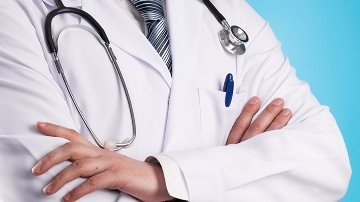
One of the causes of bradycardia is fasting. In order to lose weight, some women exhaust themselves with diets, as a result of which they notice symptoms of cardiac arrhythmia with a low pulse. Also, symptoms are often inherent in expectant mothers due to changes in hormonal levels, which requires immediate consultation with a doctor and subsequent monitoring by a specialist over the condition of the pregnant woman.
Moderate bradycardia
The average degree of bradycardia is accompanied by a slowdown in heart rate to 40 - 50 per minute. Sometimes it can be sinus, but in most cases it is associated with the formation of a rhythm from the atrioventricular connection.
This condition is typical for severe sick sinus syndrome, when the main pacemaker stops generating electrical impulses.
Causes
Possible causes of moderate bradycardia:
- congenital heart disease, including after surgical treatment;
- significant hypothyroidism;
- obstructive sleep apnea syndrome;
- coronary heart disease, including various types of angina and post-infarction cardiosclerosis;
- consequences of any open heart surgery, for example, after injury or correction of a defect.
Moderate bradycardia in combination with an irregular, irregular heartbeat may be a consequence of second degree atrioventricular block. With this rhythm disturbance, which can occur with the diseases listed above, signals from the sinus node normally excite the atria, but in the atrioventricular node some of them are completely blocked and do not pass to the ventricles.
There are two types of such blockade:
- Second degree atrioventricular block of the Mobitz-1 type, or with the Samoilov-Wenckebach periodicity. This means that impulses do not regularly pass to the ventricles. For example, out of 4 sinus signals, only three will reach the ventricular myocardium, and the fourth is blocked in the atrioventricular node (4:3 block). In this case, the pulse will be irregular: three normal beats at a normal frequency, then a pause in the heart, then three beats again, and so on. As a result, the total number of heart contractions per minute will also decrease.
- Second degree atrioventricular block of the Mobitz-2 type, or without the Samoilov-Wenckebach period. Blocking of signals in the AV node occurs irregularly and unpredictably. In this case, pauses in the work of the heart occur unexpectedly, without a clear pattern. As a result, the total number of heartbeats per minute also decreases.
Finally, another disease that may be accompanied by bradycardia is the bradysystolic form of atrial fibrillation.
There are 3 main causes of this pathology:
- cardiac ischemia;,
- mitral stenosis (heart disease with narrowing of the opening between the left atrium and the ventricle due to atherosclerosis or rheumatism);
- hyperthyroidism (increased hormonal activity of the thyroid gland).
At the same time, there is a conduction disturbance in the AV node. Therefore, not all chaotic contractions of the atria are carried out to the ventricles.
Symptoms
With moderate bradycardia, a person may feel good in a state of complete rest, lying in bed, but even with a slight load, his body begins to experience a lack of blood supply. Symptoms appear:
- dizziness when getting out of bed;
- fainting;
- severe weakness;
- inability to perform physical activity due to fatigue;
- dyspnea;
- chest pain;
- confusion;
- memory and sleep disorders.
Since the main cause of moderate bradycardia is structural (organic) damage to the heart, drug therapy is usually ineffective. In case of significant symptoms, doctors consider implanting a pacemaker in such a patient.
Medicines for bradycardia
There are several types of bradycardia and medications prescribed for its treatment:
- There was a slight decrease in heart rate when bradycardia was detected incidentally and was temporary.
- The pulse dropped to 40-50 beats per minute and concomitant heart and vascular disease was discovered.
- The presence of a severe form of bradycardia was discovered, when no drugs no longer help and there is a threat to life. Surgery is used.
Let's look at each condition and treatment methods.
For mild bradycardia
If your heart suddenly begins to slow down, your pulse drops to 60 beats per minute, you need to go to the doctor, do an ECG, and get tested. Especially in older people, this condition can occur if they take medications such as metoprolol, bisoprolol, propranolol, and other drugs in this group. If bradycardia occurs, you should immediately stop taking these medications and consult a cardiologist.
To treat this stage of bradycardia, the doctor usually prescribes drugs that improve cardiac performance at the cellular level. They do not affect the normalization of heart rate, but help strengthen the heart muscle:
- Coenzyme Q10 - optimizes all oxidative processes, improves the energy of all cells of the body, including heart cells.
- Actovegin – improves cell metabolism, promotes the accumulation of glucose and oxygen in the body’s cells.
- L-Carnitine – promotes the activation of cellular metabolism, helps cope with oxygen deficiency, and restores damaged cells.
- Piracetam - improves energy processes at the cellular level, an excellent antioxidant.
- Mexidol - prevents the oxidation of lipids in the cell membranes of all cells of the body. Helps avoid oxygen starvation of cells.
At this stage, medications are prescribed by a cardiologist. When taking these medications, you must strictly follow the dosage and doctor's recommendations. Let's look at some of these drugs.
Zelenin drops for bradycardia. This remedy will help increase your heart rate. It acts very quickly, improving the patient's condition. You need to take these drops one to three times a day before meals, 20 drops. When prescribing this drug, the doctor must explain to the patient that at the beginning of treatment for two to three days, the dose should not exceed five drops per dose.
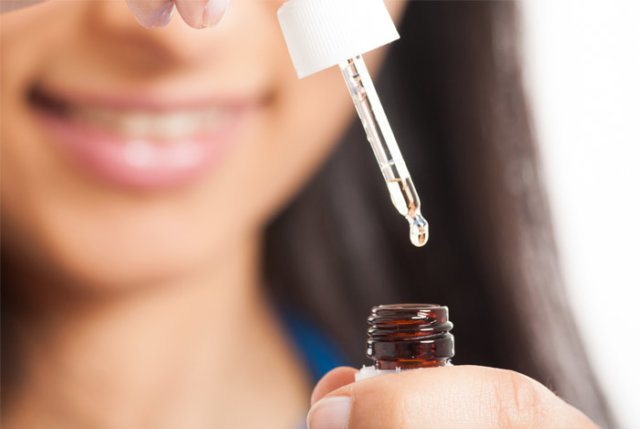
Mildronate for bradycardia - this drug is prescribed by a doctor for any heart disease - heart failure, ischemia. In the middle stage of bradycardia, it must be prescribed to the patient for the prevention of stroke and heart attack. In addition, the drug is used during intense physical activity.
Panangin is prescribed to saturate the body with potassium and magnesium, which helps strengthen the heart. It is taken in courses in the form of tablets or intravenously.
Corvalol , thanks to peppermint oil, phenobarbital and ethyl bromizovallerianate, relieves spasms, calms the nervous system and promotes rapid sleep. It is taken for tachycardia.
Cordiamine - taken for cardiac dysfunction, shock, asphyxia, poisoning.
Valerian - you can use tablets, decoctions or alcohol tinctures to calm and relieve muscle spasms.
Asparkam is prescribed for heart failure, ischemia, hypokalemia, and cardiac arrhythmias. A source of potassium and magnesium, asparkam helps restore electrolyte balance and restore heart rhythm.
Valocordin is taken as a sedative. With some cardiovascular diseases, the patient begins to panic. It is worth taking 20 drops of Valocordin tincture, nervous tension is relieved, and the heart rhythm is restored.
Concor is used for hypertension. This drug may cause bradycardia, or increased heart rate. If the patient has bradycardia, then when prescribing this drug, observation in a hospital is necessary, although some patients with arrhythmia tolerate this drug and experience relief.
Amlodipine - used to treat hypertension. This drug is prescribed with caution to patients with severe bradycardia and tachycardia.
Euffilin is used for acute heart failure.
Atropine sulfate is used for severe bradycardia, with a sharp deterioration of the condition. The drug has a pronounced specific effect, so it is taken only in severe cases. Self-administration of this drug is contraindicated!
Adrenaline is used only as prescribed by a doctor in the most severe cases. Contraindications – trachyoarrhythmia, myocardial infarction.
Bellataminal is used for neuroses, insomnia, and concussion.
Preductal for the treatment of coronary heart disease and angina attacks.
At the first signs of heart rhythm disturbances, it is necessary to change your lifestyle. Remove sugar from the table, reduce the amount of salt, eat only coarse bread, and remove fatty foods. Of course, the doctor will tell the patient about this.
It is necessary to take vitamins that will strengthen the heart and improve well-being.
Here is a list of vitamins that you should pay special attention to:
- Coenzyme Q10 will help solve many coronary problems, increase blood flow to all organs, provide the heart muscle with adequate nutrition,
- Vitamin E. Its purpose is to provide cells with oxygen, as well as improve blood circulation, reduce bad cholesterol, and cleanse blood vessels. Regulates the contraction of the heart muscle.
- Vitamin C. Its purpose is to fight atherosclerosis. It helps strengthen the walls of blood vessels, prevents unplanned blood clotting, helps overcome stress, and reduces cholesterol..
- Vitamin F – destroys saturated fats, which cause sclerotic plaques to form.
- Vitamin B6 – helps relieve vascular spasms and normalizes blood supply to the heart.
When eliminating bradycardia, the cardiologist will definitely take into account the concomitant diseases that provoked the occurrence of a decrease in heart rate. That is why a treatment course is prescribed that will affect not only an increase in heart rate, but also the treatment of the underlying disease.
- If bradycardia occurs against the background of hypertension, then medications are prescribed to lower blood pressure.
- For the treatment of atherosclerosis, statins, fibrates, and nicotine are prescribed.
- In case of ischemia (IVS), drugs are prescribed that will improve the functioning of the heart. Most often, coronary heart disease is accompanied by hypertension and atherosclerosis, then the doctor also prescribes antihypertensive drugs and drugs.
When taking medications, carefully read the instructions and strictly follow the doctor's recommendations!
Source: cardiogid.ru


